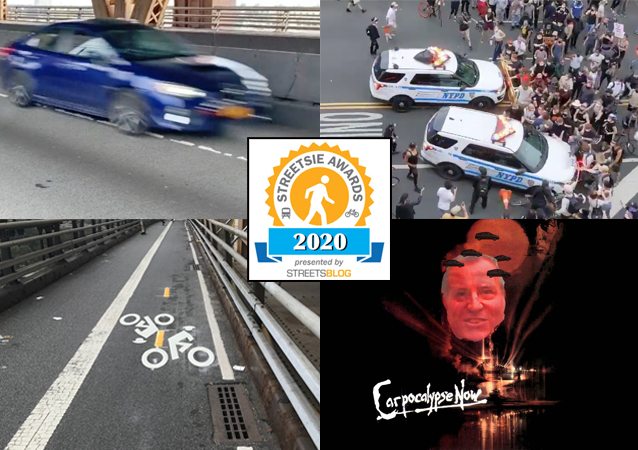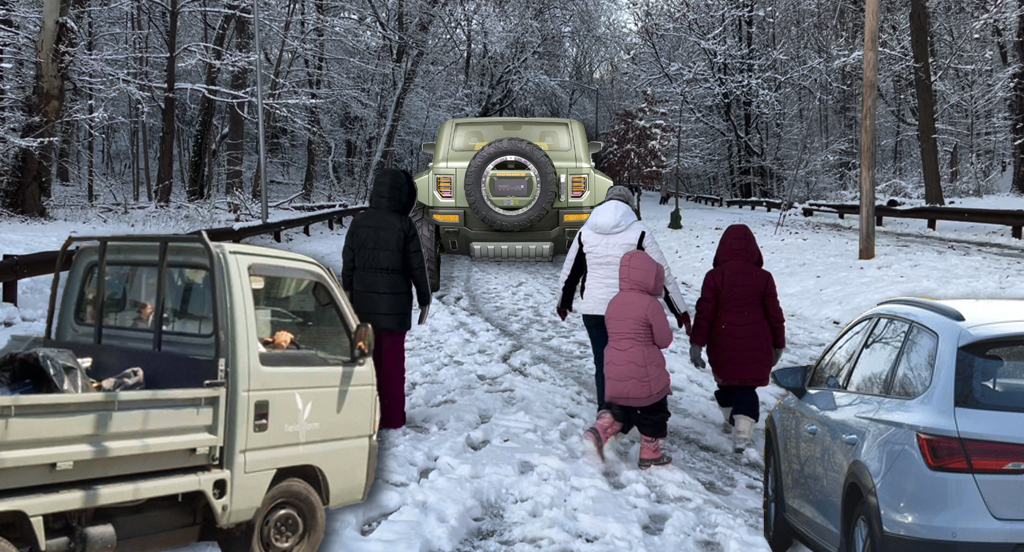
Before we throw 2020 into the blazing Dumpster, it's time for our annual year-in-review-style awards show. Today, we're publishing twin articles looking at the worst that 2020 had to offer, but also finding the tarnished silver lining in the cloud of despair that has covered this city from March to date.
If you want to live in a honey-hued world, click here for our "Best News of the Year" story, and the Streetsie award for the single best transportation development of the year. But if you want to live in the real world, enjoy our annual, "Worst Transportation News of the Year" award story.
And the nominees for the ignominious prize are:
The rise in car ownership
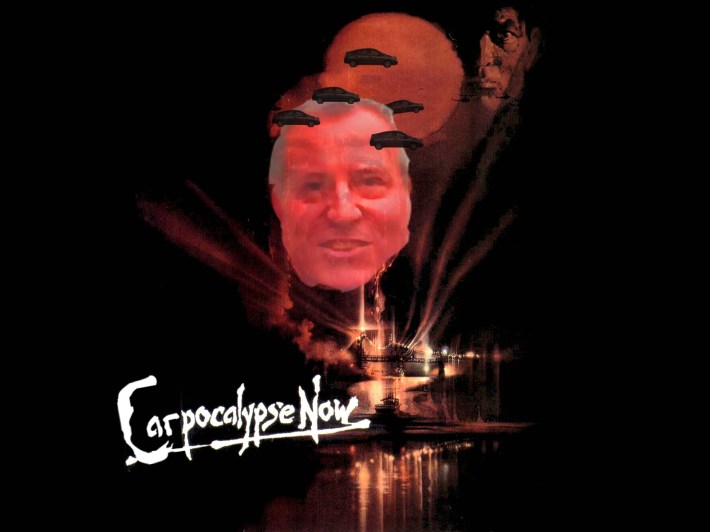
Wow, imagine that — in the face of a pandemic when public officials were urging us to avoid crowds, many New Yorkers decided to buy cars, with car registrations hitting new highs this summer, as The City reported. Who would have thought that would happen? Um, pretty much everyone! We spent most of March advising Mayor de Blasio to plan ahead for the inevitable and easily predictable "carpocalypse" (even creating a cool logo to accompany all our coverage), but Hizzoner wouldn't listen.
Study after study predicted it, but Hizzoner still wouldn't listen.
Finally, the mayor did listen to us (Streetsblog gets action!) and appointed a surface transportation panel to help him figure out what to do. But then he ignored its recommendations, and the carmageddon continued. Congestion has not yet fully returned to Manhattan, but the boroughs are experiencing more traffic than before the pandemic, an indication that car culture has locked its talons into New Yorkers and altered behavior that may take a generation to undo.
The increase in car ownership led to several of our other nominees...
The speeding (and death) epidemic
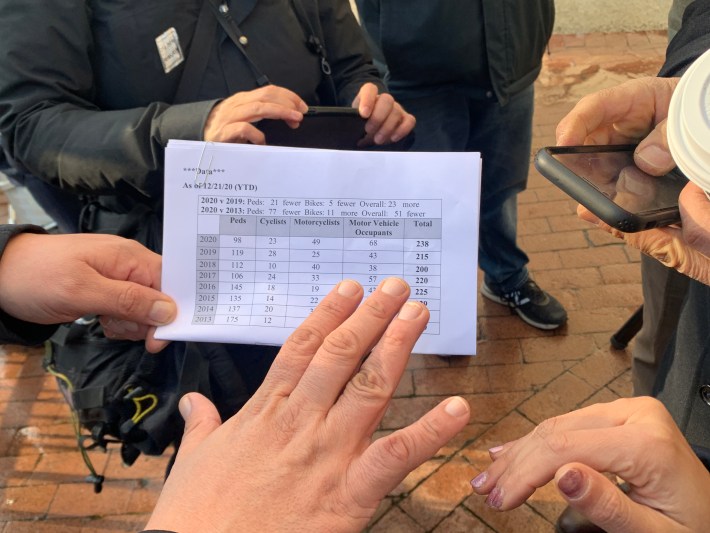
We noticed it almost immediately: With roads emptied due to the complete cessation of economic activity in the city, the few remaining drivers were driving recklessly. For weeks, we pounded that drum, until we also noticed that fatalities were starting to rise, even as crashes were down.
The reason? The fewer crashes were far more violent — and therefore more deadly — because the speeds were so much higher.
Meanwhile, the NYPD did little to crack down on the recklessness, which we also reported.
It all adds up to a terrible year for road violence in the city, with the year expected to end with even more road deaths than last year, which itself was an increase from the year before. As of the middle of last week, close to 240 people had already been killed on New York City roadways, up from 215 during the same period last year and 200 the year before. It's already the bloodiest year since 2014, the first year of Vision Zero.
The mayor failed on buses
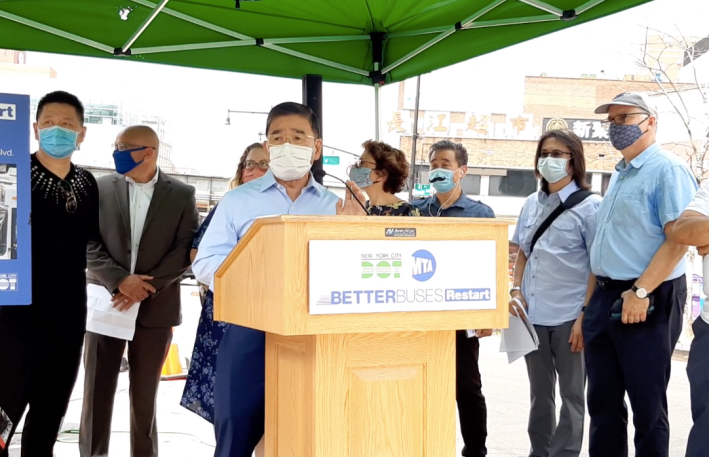
One bright spot this year was when Mayor de Blasio summoned the press in June to a live media avail (the first since the pandemic started) and announced the creation of five new car-free busways, plus 16 miles of dedicated bus lanes.
The good news faded quickly, considering that the MTA, eying the carmageddon we mentioned above, had asked for 60 miles of bus lanes. Worse, it quickly became clear that the mayor's eyes for change were bigger than his stomach to take on anti-transit, pro-car forces.
First, the mileage of the dedicated bus lanes were cut to accommodate Staten Island car drivers. Then, the Flushing busway was stalled to appease a racist City Council member. The mayor also abandoned a car-free busway on Fifth Avenue in Manhattan to appease mom and pop stores with names like Tiffany, Coach and Rolex.
In the end, even the mayor was forced to admit that the signature transportation initiative of the pandemic would likely sputter to a conclusion.
This wouldn't be such a big deal — after all, car traffic is down — but bus speeds were basically flat during the pandemic. The average bus speed in January was 8.1 miles per hour and have been averaging 8.3 miles per hour since July. It's nice that it's going in the right direction, but there's no question that bus speeds would be better if the mayor was more aggressive about reducing the hegemony of the automobile on every single street except 14th Street in Manhattan and Fulton Street in Brooklyn.
Police use their squad cars and bikes to abuse protesters
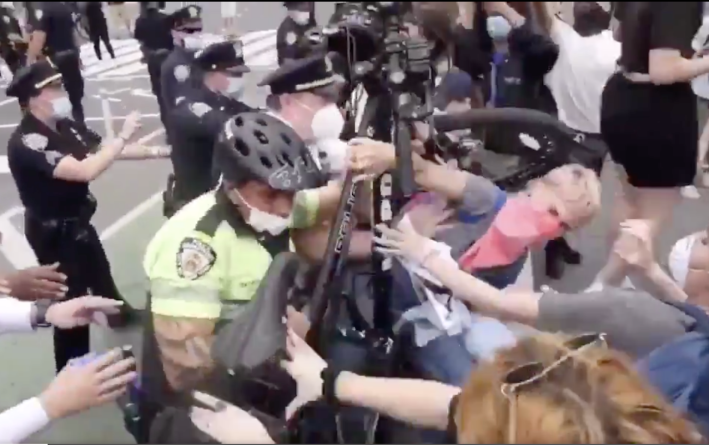
Though it doesn't count as transportation policy, the single most egregious transportation image from this year was the sight of NYPD officers using their squad cars and bikes to abuse peaceful protesters during this summer's rallies against, well, police misconduct.
Very early in the George Floyd protests, cops were caught on camera in multiple locations pushing protesters with their SUVs, an abuse that the mayor immediately vowed to investigate and punish, but whose investigation and punishment remains stalled. The NYPD's notorious Strategic Response Group also used bikes as weapons to push back protesters.
Department of Investigation Commissioner Margaret Garnett criticized the police use of bikes as a weapon, but admitted that her investigation did not pursue individual officers, leaving that decision up to Attorney General Letitia James, who claims to be investigating.
The big stall

In conjunction with his efforts to ignore his own surface transportation committee, the mayor gutted some of his own projects through budget cuts.
Early in the pandemic, he cut several Vision Zero initiatives, including the Green Wave proposal that had been rolled out only a year earlier during an earlier crisis of road deaths. He also cut two units that fight placard corruption.
As a result, many bike lane projects were stalled (though, in fairness, the city installed the most protected bike lane miles in its history this calendar year) and there was literally no crackdown on placard abuse (in fact, as Streetsblog reported, the NYPD even broke city law to avoid cracking down on placards), even though the mayor had heralded such a crackdown in February, 2019.
The dangerous Queensboro Bridge
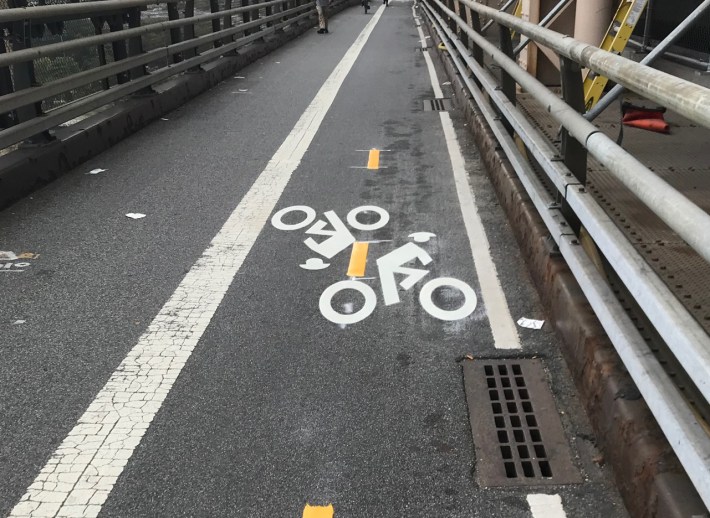
Last but certainly not least is the most contemptible failure of the de Blasio administration this year: Failing to create more space for cyclists and pedestrians on the Queensboro Bridge, where bikers and walkers share a narrow strip of turf in each direction, even as drivers get nine lanes to and from Manhattan. Let's go over the facts:
Bike riding is surging over the Queensboro Bridge, while car trips are down. Meanwhile, cyclists are getting injured frequently as there is barely enough room for two riders to pass each other (even the city DOT's own stencils on the bridge appear to be crashing into each other — that's how little room there is up there).
Streetsblog has been covering this outrage all year, but the city Department of Transportation consistently said it could not turn the bridge's under-used South Outer Roadway into a pedestrian-only path. The agency says it needed all car lanes until a repair project is done in 2022, but then came up with a new excuse, claiming that the south outer roadway would need a special fence to prevent suicides by pedestrians (though currently drivers can leap the existing fence with no deterrence).
But Streetsblog pressed on, eventually getting Council Members Jimmy Van Bramer of Queens and his Manhattan counterpart Ben Kallos to commit to providing the funding for the fence. After that, then-Commissioner Polly Trottenberg said she would gratefully take the money.
Then, nothing. Since August, the DOT has stopped responding to questions about when it will turn Van Bramer and Kallos's cash into a fence. Trottenberg subsequently resigned — and neither Van Bramer nor Kallos has heard anything either. Sad.
And the Streetsie for "Worst Piece of Transportation News of 2020" goes to ... the Queensboro Bridge saga!
Though they were moved by the increase in deaths, the NYPD's ongoing misconduct, and poor performance on buses, judges said they went with the Queensboro Bridge because it's such a symbol of something so easy that is nonetheless caught up in this administration's failure to even do the least that it could do.
